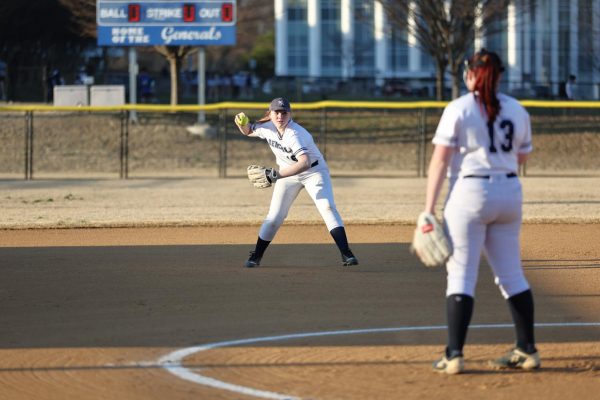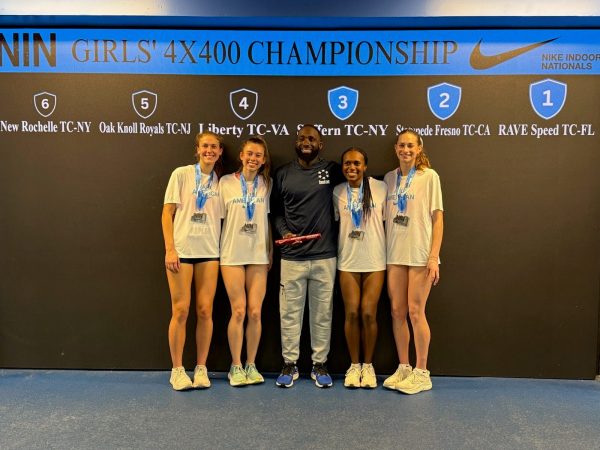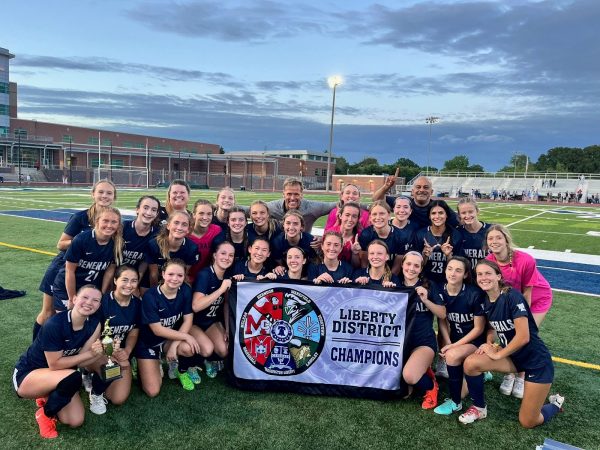Ahead of the game
Junior Alejandro Maldonado-Romero heads the ball during a W-L soccer game.
Following a 2014 class action lawsuit against the United States Soccer Federation (USSF), also known as U.S. Soccer, the federation announced new safety measures intended to protect players from head injury. These initiatives included changing substitution rules, increasing concussion awareness, banning all heading of soccer balls for children under the age of 10 and prohibiting heading during practice for players ages 11 to 13. Both U.S. Soccer and Major League Soccer (MLS) youth teams will be required to adhere to the provisions, however USSF does not have authority to require other youth programs to comply.
Over the past decade, concussions have become more prevalent in youth and professional leagues. Behind American football, women’s soccer is the second leading sport in its number of concussions, followed by men’s soccer. According to the U.S. National Library of Medicine, 22 percent of male soccer players and 36 percent of female players in high school have suffered a concussion sustained during either practice or competition. “Concussions are really common in soccer, so when someone gets one I feel like it is seen as not a big deal,” freshman Maeve Marsh said. “I know a lot of people who play through concussions because they do not know how serious they are.”
Similar to youth soccer, there is a high number of concussions in professional leagues. According to a study conducted by Reuters Health from 2001 to 2012, 66 percent of all professional players in the Union of European Football Associations (UEFA) Champions League sustained at least one concussion during their career. For most of the sport’s history, players who sustained a head injury during a game chose whether they were fit to continue playing, a policy that allowed players to ignore symptoms of concussions and other serious brain trauma in order to stay in the game. “I just do not think preventing all head injuries in soccer is possible,” junior Anna Beatrice said. “Most of the players on my soccer team have been hurt from heading the ball, but heading is an important part of the game that should not be eliminated.”
Although concussions are now seen as a problem that must be dealt with, the solution is not as obvious. The first setback to decreasing these injuries is that fact that most concussions are not easily detected nor are a large number of them reported. Secondly,even if a concussion is diagnosed, head injuries are subjective. “I think anytime you have a player get injured it’s concerning, but a concussion presents a different type of problem,” boys varsity soccer head coach Mr. Jimmy Carrasquillo said. “It’s something that is gaged by the athlete and each player deals with injuries differently because they deal with pain differently, so it can be tricky.” Because almost no scientific studies were conducted before the 1990s regarding concussions, there is no accepted measures for prevention or treatment that have become the standard for handling this issue.
As of 2014, the Fédération Internationale de Football Association (FIFA), the governing body of international soccer, has implemented a rule that gives referees the ability to allow three minutes for a team physician to give on-field care to a player who has been involved in a head-on collision or shows concussion-like symptoms. Additionally, the injured player cannot return to the game without the authorization of the team doctor. Besides this initiative addressing concussions in professional games, almost no major changes have been made to solve the problem, especially for young players, until late last year. “I remember hearing about players who had serious concussions but still stayed in the game, so I think the new rule will really help end that,” junior Isaac Gamboa said. “It seems like the first time FIFA has cared about players’ safety.”
In wake of FIFA’s move, the lawsuit against U.S. Soccer was filed, calling for similar actions ensuring player safety. U.S. Soccer’s announcement last November does not replicate FIFA’s concussion protocol, instead focusing on preventing head injuries from occurring in youth teams. The reaction has been split; while some see this proposal as too rash or sensitive, other call U.S. Soccer’s move the right thing to do. “I think at a younger age, taking heading out of the equation is smart,” former U.S. Soccer midfielder Julie Foudy said during an interview with ThePostGame. “Eight, 10, 12-year-olds…do not need to be launching balls and taking contact with your head.”
While U.S. Soccer argues limiting heading on youth teams will decrease the number of concussions, there is discussion as to whether U.S. youth national teams and MLS youth teams affected by this decision will suffer. “We are already behind most other countries when it comes to soccer,” Marsh said, “and keeping youth national teams from heading will only hurt us from developing good soccer players.” Although U.S. Soccer now limits the mastering of heading for its players, soccer experts have argued that ruling out heading could lead to more players who are skilled with their feet. No matter which side is correct, the new protocol will impact player development in some way.
Another criticism with U.S. Soccer’s solution is that since heading is not the only cause of head injuries, the problem is not fully addressed with the new proposal. Many other causes, such as head to head contact and impact with the ground, have been shown to result in a large number of concussions in soccer. “Restricting the amount of time heading the ball is a way for U.S soccer to say they are addressing the issue but I don’t think it will really change the amount of concussions reported,” Mr. Carrasquillo said. “I believe more concussions are results of collisions and falls, rather than heading the ball.” Since there are different ways besides heading balls that lead to this head trauma, not just one solution implemented would cover the scope of the problem. “I honestly don’t think there is [only] one thing can be done to really reduce the number of concussions in soccer,” Mr. Carrasquillo said. “I believe a few things need to happen.” These measures include practicing heading with a softer ball to lessen impact to the brain and strengthening neck muscles of players to help them be less vulnerable to injury.
Because heading counts for a large number of concussions in soccer, USSF chose players’ safety over the potential to groom the next Abby Wambach, a prolific forward known for scoring with her head. As the new rules go into effect, U.S. Soccer will see how effective their policies will be in the hopes of potentially implementing aspects of it with U.S. senior national teams in the future, and possibly to teams outside of the federation. “If it is successful, then U.S. Soccer should try to get these rules passed for all youth soccer programs, not just national teams and MLS,” Marsh said. “The more players it reaches, the more safe the game will be.”








